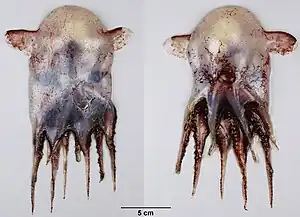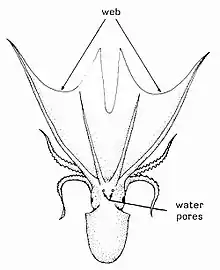
Cirrate octopuses possess a well-developed internal shell that supports their muscular swimming fins. This is in contrast to the more familiar, finless, incirrate octopuses, in which the shell remnant is either present as a pair of stylets or absent altogether.[1]
The cirrate shell is quite unlike that of any other living cephalopod group and has its own dedicated set of descriptive terms.[2][3] It is usually roughly arch- or saddle-shaped and is rather soft, being similar in consistency to cartilage.[4] Each of the eight extant cirrate genera is characterised by a distinct shell morphology:[5]
- Cirroteuthidae
- Cirroteuthis — saddle-shaped, with large wings
- Cirrothauma — butterfly-shaped
- Opisthoteuthidae
- Cirroctopus — V-shaped, lateral wings tapering to fine points
- Cryptoteuthis — U-shaped, each lateral wing ending in broad lobe with pointed projection[6]
- Grimpoteuthis — U-shaped, lateral wings ending bluntly
- Luteuthis — W-shaped
- Opisthoteuthis — U-shaped, lateral wings usually tapering to fine points but termination complex in certain species[7]
- Stauroteuthidae
- Stauroteuthis — U-shaped
The comparatively simple shells of Opisthoteuthidae and Stauroteuthidae are thought to approximate the ancestral shape, with those of Cirroteuthidae being more derived.[8] The shell of Cirroctopus appears transitional in form between those of incirrate octopuses and other cirrates, and resembles the reduced shell of the Late Cretaceous Palaeoctopus newboldi.[8] The paired, rod-shaped stylets of incirrates are evolutionarily derived from the lateral wings and horns of the cirrate shell.[8]
References
- ↑ Fuchs, D., C. Ifrim & W. Stinnesbeck (2008). A new Palaeoctopus (Cephalopoda: Coleoidea) from the Late Cretaceous of Vallecillo, north-eastern Mexico, and implications for the evolution of Octopoda. Palaeontology 51(5): 1129–1139. doi:10.1111/j.1475-4983.2008.00797.x
- ↑ Young, R.E., M. Vecchione & K.M. Mangold (1999). Cephalopoda Glossary. Tree of Life Web Project.
- ↑ Young, R.E., M. Vecchione & K.M. Mangold (2002). Cirrate Shell Terminology. Tree of Life Web Project.
- ↑ Vecchione, M., K.M. Mangold & R.E. Young (2010). Cirrata Grimpe, 1916. Tree of Life Web Project.
- ↑ Collins, M.A. & R. Villanueva (2006). Taxonomy, ecology and behaviour of the cirrate octopods. In: Gibson, R.N., R.J.A. Atkinson & J.D.M. Gordon (eds.) Oceanography and Marine Biology: An Annual Review. Aberdeen University Press, Aberdeen. pp. 277–322.
- ↑ Collins, M., R. Villanueva & R.E. Young (2008). Cryptoteuthis Collins, 2004. Tree of Life Web Project.
- ↑ Villanueva, R., R.E. Young & M. Vecchione (2008). Opisthoteuthis Verrill 1883. Tree of Life Web Project.
- 1 2 3 Bizikov, V.A. (2004). Evolution of shell in Octopodiformes (Cephalopoda) Archived 2013-10-21 at the Wayback Machine. In: Abstracts of the conference Mollusks of the Northeastern Asia and Northern Pacific: Biodiversity, Ecology, Biogeography and Faunal History. October 4–6, 2004, Vladivostok, Russia. pp. 21–23.
Further reading
- Bizikov, V.A. (2004). The shell in Vampyropoda (Cephalopoda): morphology, functional role and evolution. Ruthenica 3: 1–88.
- Haas, W. (2002). The evolutionary history of the eight-armed Coleoidea. Abhandlungen der Geologischen Bundesanstalt, Wien 57: 341–351.


